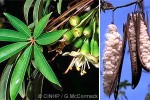Cook Islands Biodiversity Database
Species Page
Ceiba pentandra
Mama‘uKapok
Multimedia & Additional Resources
| Type | Description | Download |
| Leaf, flower and open pods | 68KB | |
| Tree with open pods | 67KB | |
| Tree with green pods, detail of open pod | 72KB |
General Information
Cook Islands Distribution
| Southern Group: Present Makatea: Present | ||||||||
RR |
MG |
AT |
MK |
MT |
AK |
PL |
TK |
MN |
+++ |
+++ |
+++ |
+++ |
+++ |
+++ |
- |
- |
- |
| Northern Group: - | |||||
TN |
MH |
RK |
PK |
NS |
SW |
- |
- |
- |
- |
- |
- |
Scientific Taxonomy
Ceiba pentandra Linnaeus
SYNONYMS: Ceiba pentandra var. pentandra; Ceiba casearia [sensu GW]; Bombax pentandra; Bombax malabaricum [sensu TC]
TAXONOMY: PLANTAE; ANTHOPHYTA (=Angiospermae); MAGNOLIOPSIDA (=Dicotyledones); DILLENIIDAE; Malvales; BOMBACACEAE
More Information
SIGNIFICANCE NOTES -
POSITIVE SIGNIFICANCE: Material (Fibre). Comments: MATERIAL: The wooly packing material surrounding the seeds (inside the fruit capsules) is Kapok, used to stuff pillows and mattresses (Whistler 1990). Due to being non-absorbent Kapok is used in life preservers (Wilder 1931). Wood very soft.
Vouchers & References
Vouchers:
None Recorded.
References:
p.572 Neal - In Gardens of Hawaii
p.239 Hortus 3rd
p.225 Royal Hort. Soc. Index of Garden Plants
p.197 Tropica
p.2/413 A.C.Smith - Flora Vitiensis Nova
p.274 R* Cheeseman - Flora of Rarotonga
p.74 Wilder - Flora of Rarotonga
p.411f Whistler - Ethnobotany of the Cook Islands
Data Update History (information):
zTX, zB02, zM02, zD02
Web Resources
Citation Information
McCormack, Gerald (2007) Cook Islands Biodiversity Database, Version 2007.2. Cook Islands Natural Heritage Trust, Rarotonga. Online at http://cookislands.bishopmuseum.org. ![]()
Please refer to our use policy.

